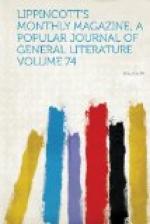In 1765, his purse having become somewhat more plethoric, he removed to Garden Court, then, as now, one of the choice spots in the Temple Area. Here he sported a man-servant, and ran head over ears in debt to his trades-people. Three years later, in 1768, we find the happy-go-lucky spendthrift squandering four hundred of the five hundred pounds which the partial success of “The Good-Natured Man” netted him in the purchase of a set of chambers in No. 2 Brick Court, much to the sorrow of the studious Blackstone, whose fellow-tenant he thus became. The nocturnal revelries of Goldy and his intimates are happily described in Mr. Forster’s biography. Supper-parties were frequent, “preceded by blind-man’s-buff, forfeits, or games of cards, when Goldsmith, festively entertaining them all, would make frugal supper for himself off boiled milk.” He would “sing all kinds of Irish songs,” and with special enjoyment “gave them the Scotch ballad of ‘Johnny Armstrong’ (his old nurse’s favorite);” with great cheerfulness “he would put the front of his wig behind, or contribute in any other way to the general amusement;” and to an “accompaniment of uncontrolled laughter he once danced a minuet with Mrs. Seguin,” the wife of an Irish merchant.
A volume would not contain the thrilling story of the trials and triumphs, the struggles and successes, of the dead-and-gone generations whose feet have polished the cool gray flags of the purlieus of the Temple. Comedy and tragedy have been enacted within its walls; penury and prodigality have dwelt beneath the same rafters; the versatile genius and the plodding dullard have taken their maiden flights toward fame in its halls. Soldiers and statesmen, poets and playwrights, courtiers, wits, and adventurers, have herein acted their various parts. Yet, despite the checkered lives that have run their course within its pale, and notwithstanding the lustre shed upon its history by the many great jurists nurtured there, the Temple gains its greatest renown from the residence therein of that famous trio, Johnson, Goldsmith, and Lamb.
The immortal pump, so often alluded to in the Temple annals, stands in the centre of Hare Court,—not in Pump Court, as might not unreasonably be expected. It yields a copious supply of the coolest spring-water, and the office-lads of the surrounding chambers make many pilgrimages hither, stone pitcher in hand, during the sultry summertime. Charles Lamb, in an epistle to Coleridge, in his happiest vein, says, “I have been turned out of my chambers in the Temple by a landlord who wanted them for himself; but I have got others at No. 4, Inner Temple Lane, far more commodious and roomy.... The rooms are delicious, and the best look backwards into Hare Court, where there is a pump always going; just now it is dry. Hare Court’s trees come in at the window,—so that it’s like living in a garden.” Again, writing from the Temple in 1810 to his friend Manning, who is in China, Lamb says, “The household




